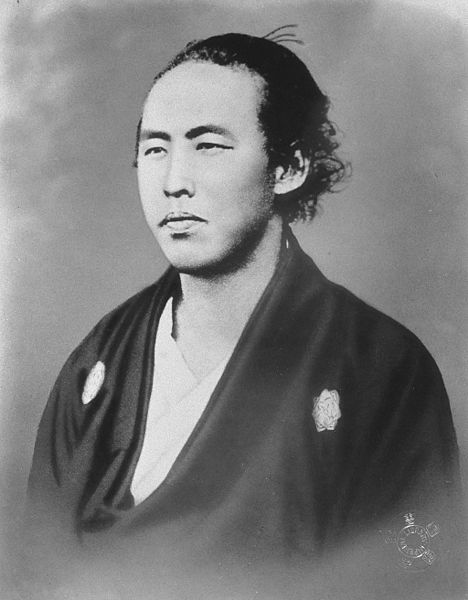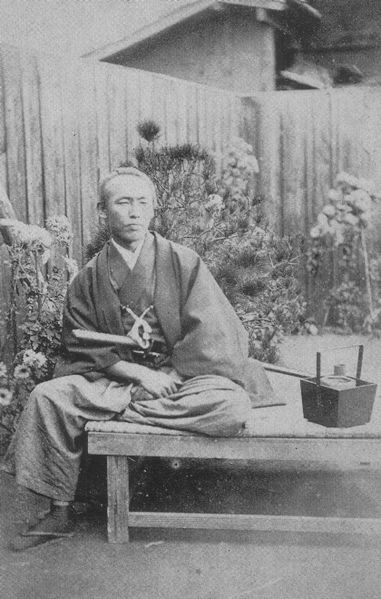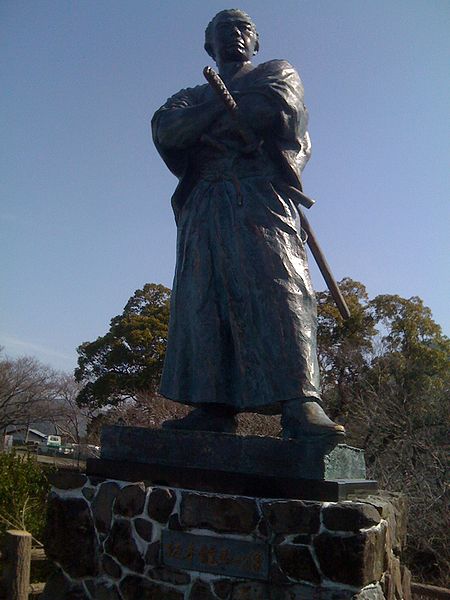<Back to Index>
- Samurai and Politician Sakamoto Ryōma, 1836
PAGE SPONSOR



Sakamoto Ryōma (坂本 龍馬, January 3, 1836 – December 10, 1867) was a leader of the movement to overthrow the Tokugawa shogunate during the Bakumatsu period in Japan. Ryōma used the alias Saidani Umetarō (才谷 梅太郎).
Ryōma was born in Kōchi, of Tosa han (present day Kōchi Prefecture), on the island of Shikoku. By the Japanese calendar, he was born on the 15th day of the 11th month, of the sixth year of Tenpō. Previous generations of his family had acquired enough wealth as sake brewers to purchase the rank of merchant samurai, or goshi, which was the lowest rank in the samurai social hierarchy (unlike other domains, Tosa had very strictly distinct joshi (high rank samurai) and kashi (low rank samurai)). Joshi and kashi were treated unequally and they lived in separate places, also in Sakamoto Ryōma generation's (the third generation in the Sakamoto family), his family's samurai rank was kashi. At the age of twelve, Ryōma was enrolled in a private school, but this was a short lived episode in his life, as he showed little scholarly inclination. His older sister enrolled him in fencing classes when he was 14, after he was bullied at school. By the time he reached adulthood he was a master swordsman. In 1853, he was in Edo as a disciple of Chiba Sadakichi, a master swordsman of the Hokushin Ittō - ryū style of kenjutsu. That year, Commodore Perry of the United States arrived with a fleet of ships to force Japan out of its centuries old national isolation policy.
When Ryōma finished his studies in 1858, he returned to Tosa. In 1862, his friend, Takechi Hanpeita
(or Takechi Zuizan), organized the Tosa Loyalist Party "Kinnoto". Their
political slogan was, “Revere the Emperor, Expel the Foreigners”. It
consisted of about 200 samurai, mostly from the lower rank, who insisted
on the reform of the Tosa government. Since the Tosa lord refused to
recognize the group, they plotted to assassinate Yoshida Toyo (later,
Yoshida Toyo was assassinated after Ryōma left Tosa). Ryōma participated
in name only, because Takechi demanded a revolution for only the Tosa
clan, and Ryōma thought they should to do something for all of Japan. He
decided to leave Tosa and separate from Takechi. In those days, nobody
was permitted to leave their clan without permission, on penalty of
death. One of Ryōma’s sisters committed suicide because he left without
permission. Sakamoto would later use the alias "Saitani Umetarō" (才谷
梅太郎) as he worked against the shogun.
While a ronin, Ryōma decided to assassinate Katsu Kaishū, a high ranking official in the Tokugawa shogunate and a supporter of both modernization and westernization. However, Katsu Kaishū persuaded Ryōma of the necessity of a long term plan to increase Japan’s military strength. Instead of killing Katsu Kaishū, Ryōma started working as his assistant and protégé.
In 1864, as the Tokugawa shogunate started taking a hard line, Ryōma fled to Kagoshima in Satsuma domain, which was developing as a major center for the anti - Tokugawa movement. Ryōma negotiated the secret alliance between Chōshū and Satsuma provinces. Satsuma and Chōshū historically had been absolute enemies, and Ryōma's position as a "neutral outsider" was critical in bridging the gap in trust.
Ryōma is often regarded as the "father of the Imperial Japanese Navy", as he worked under Katsu Kaishū's direction toward creating a modern naval force (with the aid of western powers) to enable Satsuma and Chōshū to hold their own against the naval forces of the Tokugawa shogunate. Ryōma founded the private navy and trading company Kameyama Shachū (亀山社中) in Nagasaki City by the help of Satsuma. Later Kameyama Shachū became Kaientai or Ocean Support Fleet.
Chōshū’s subsequent victory over the Tokugawa army in 1866 and the impending collapse of the Tokugawa shogunate made Ryōma a valuable commodity to his former masters in Tosa. Ryōma was recalled to Kōchi with honors. The Tosa domain was anxious to obtain a negotiated settlement between the Shogun and the Emperor, which would prevent the powerful Satchō Alliance from overthrowing the Tokugawa by force and thus emerging as a new dominant force in ruling Japan. Ryōma played a crucial role in the subsequent negotiations that led to the voluntary resignation of the Shogun Tokugawa Yoshinobu in 1867, thus bringing about the Meiji Restoration.
Ryōma was assassinated
at the age of 33 (according to the old lunar calendar he was born on
the 15th day of the 11th month, and killed on his birthday in 1867) at
the Ōmiya (近江屋) inn in Kyoto, not long before the Meiji Restoration took place. Initial reports accused members of the Shinsengumi for Ryōma and Nakaoka Shintarō's deaths (and Shinsengumi leader Kondō Isami was allegedly executed on that pretense), but another pro - Shogun group, the Mimawarigumi's Imai Nobuo confessed to the murder in 1870. Although Sasaki Tadasaburō and Imai Nobuo carry the blame, the true assassin has never been proven in a court of law.
Ryōma was a visionary who envisioned a Japan without any feudal trappings. He read about and was inspired by the example of the United States where "all men are created equal". He realized that in order to compete with an industrially and technologically advanced outside world, the Japanese people needed to modernize. He has also been seen as an intriguing mix of the traditional and modern, symbolized by his preference for samurai dress while favoring western footwear.
Ryōma has been heavily featured and romanticized in popular culture, occupying a place in the Japanese imagination similar to that of Lord Byron
in the British, while interest in memorabilia related to Ryōma and
conspiracy theories regarding his assassination are reminiscent of
interest in the assassination of John F. Kennedy and related conspiracy theories in American culture.
On 15 November 2003, the Kōchi Airport was renamed to the Kōchi Ryōma Airport in his honor.
There is a Sakamoto Ryōma Memorial Museum (坂本龍馬記念館) in Kōchi.
On 15 November 2009, Hokkaidō Sakamoto Ryōma Memorial Museum was built in Hakodate, Hokkaidō.
Asteroid 2835 Ryoma is named after him. Asteroid 5823 Oryo is named after his wife.
An April 2010 Japan Times article wrote "Ryōma has inspired at least seven television drama series, six novels, seven manga and five films." His appeal stems from being "the kind of person onto whom anyone can project themselves", as actor Masaharu Fukuyama described his role playing him in the NHK drama Ryōmaden. He is also depicted in the Japanese medical / historical - fiction manga series Jin.
Sakamoto is also a recurring character in the NHK Taiga Drama: Shinsengumi!. He is portrayed as a friend of Kondō Isami since their younger days. In the drama he is assassinated by Sasaki Tadasaburō and the Mimawarigumi.
Sakamoto appears in the historical manga Shura no Toki, which was later adapted into the anime, Mutsuen Meiryū Gaiden: Shura no Toki.
The popular Gintama series has been a character named Sakamoto Tatsuma, head chief of Kaientai, which is based on Ryōma.
He appears in the Bakumatsu chapter of the SNES game Live A Live as a prisoner that the player must rescue.